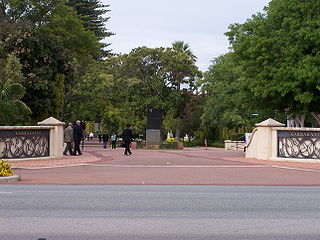
Golders Green Crematorium and Mausoleum was the first crematorium to be opened in London, and one of the oldest crematoria in Britain. The land for the crematorium was purchased in 1900, costing £6,000, and the crematorium was opened in 1902 by Sir Henry Thompson.

Rookwood Cemetery is a heritage-listed cemetery in Rookwood, Sydney, New South Wales, Australia. It is the largest necropolis in the Southern Hemisphere and is the world's largest remaining operating cemetery from the Victorian era. It is close to Lidcombe railway station about 17 kilometres (11 mi) west of the Sydney central business district. It was added to the New South Wales State Heritage Register on 2 April 1999.

The City Road Cemetery is a cemetery in the City of Sheffield, England that opened in May 1881 and was originally Intake Road Cemetery. Covering 100 acres (40 ha) it is the largest and is the head office for all the municipally owned cemeteries in Sheffield. The cemetery contains Sheffield Crematorium, whose first cremation was on 24 April 1905.

Karrakatta Cemetery is a metropolitan cemetery in the suburb of Karrakatta in Perth, Western Australia. Karrakatta Cemetery first opened for burials in 1899, the first being that of wheelwright Robert Creighton. Managed by the Metropolitan Cemeteries Board, the cemetery attracts more than one million visitors each year. Cypress trees located near the main entrance are a hallmark of Karrakatta Cemetery. The cemetery contains a crematorium, and in 1995 Western Australia's first mausoleum opened at the site.
Cornelian Bay is a small suburb in Hobart, Tasmania, Australia. It lies just north of the urban parkland, the Queens Domain. The bay itself is a safe anchorage for yacht owners.

Aldershot Military Cemetery is a burial ground for military personnel, or ex-military personnel and their families, located in Aldershot Military Town, Hampshire.

The Springvale Botanical Cemetery is the largest crematorium and memorial park in Victoria, Australia, located in the southeastern Melbourne suburb of Springvale.

South London Crematorium and Streatham Park Cemetery is a cemetery and crematorium on Rowan Road in Streatham Vale. It has always been privately owned and managed and is now part of the Dignity plc group. The South London Crematorium is situated within the cemetery grounds and opened in 1936.

Charles Ernest Culley CMG was an Australian politician. He was a member of the Australian Labor Party (ALP) and served in the Australian House of Representatives (1928–1931) and Tasmanian House of Assembly (1934–1948). He was an assistant minister in the federal Scullin government and later became a minister in the Tasmanian state government.

Carleton Crematorium, together with the adjacent necropolis, Carleton Cemetery, is a graveyard located within the Greenlands ward of Blackpool with its main entrance on Stocks Road in Carleton, Poulton-le-Fylde, Lancashire, in England. It was opened on 18 July 1935.

Southern Cemetery is a large municipal cemetery in Chorlton-cum-Hardy, Manchester, England, 3 miles (4.8 km) south of the city centre. It opened in 1879 and is owned and administered by Manchester City Council. It is the largest municipal cemetery in the United Kingdom and the second largest in Europe.

Woking Crematorium is a crematorium in Woking, a large town in the west of Surrey, England. Established in 1878, it was the first custom-built crematorium in the United Kingdom and is closely linked to the history of cremation in the UK.

Karori Cemetery is the second-largest cemetery in New Zealand. It opened in 1891, and is located in the Wellington suburb of Karori.

Francis Henry Foster was an Australian pastoralist, businessman and politician. He was born in Brighton, Sussex, England, the eldest son of Colonel Henry Foster, a Tasmanian farmer. His grandfather was John Foster, a Tasmanian farmer, businessman and politician, and his great-uncle was William Foster who had been Solicitor General for New South Wales and member of the New South Wales Legislative Assembly. After military service during the First World War, Francis Foster was a successful businessman who served as member of the Tasmanian House of Assembly between 1937 and 1941.
The Northern Suburbs Crematorium, officially Northern Suburbs Memorial Gardens and Crematorium, is a crematorium in North Ryde, New South Wales, a suburb of Sydney, Australia. It was officially opened on 28 October 1933, and the first cremation took place on 30 October 1933.

William Douglas Leitch, born in Hobart, Tasmania to Scottish settlers John Leitch and Jean McCrone from Paisley, Renfrewshire, was a Tasmanian footballer, businessman and sports administrator. Leitch was an employee and later board of directors member of Henry Jones's IXL jam manufacturing business; taking his first job at the company at the age of only ten alongside Sir Henry Jones placing labels on jam tins, and working there until his death, he gave almost seventy years continuous service. Many of his sons would also have careers working for the firm during their lifetimes.

Mount Thompson Memorial Gardens and Crematorium includes a heritage-listed chapel, columbaria and other features. It is located on north-western slopes of Mount Thompson in Brisbane, Australia. The street address is Nursery Road in Holland Park. It was established in 1934 as the first crematorium in Queensland.

Mortlake Cemetery is a cemetery in Kew in the London Borough of Richmond upon Thames. It is also known as Hammersmith New Cemetery as it provided burials for the then Metropolitan Borough of Hammersmith when Margravine Cemetery was full. The cemetery opened in 1926 and is still in use. It is now managed by Hammersmith and Fulham Council.

Enfield Crematorium is a cemetery located on the Great Cambridge Road, Enfield, London. It was opened in 1938 and consists of 50 acres (20 ha) of land, most of which is dedicated to the gardens of remembrance. The crematorium is a local listed red brick building.

Bournemouth North Cemetery and Bournemouth Crematorium is a municipal cemetery in Bournemouth, England. The cemetery is located between the suburbs of Charminster, Strouden Park and Queen's Park and is owned by Bournemouth, Christchurch and Poole Council.



















